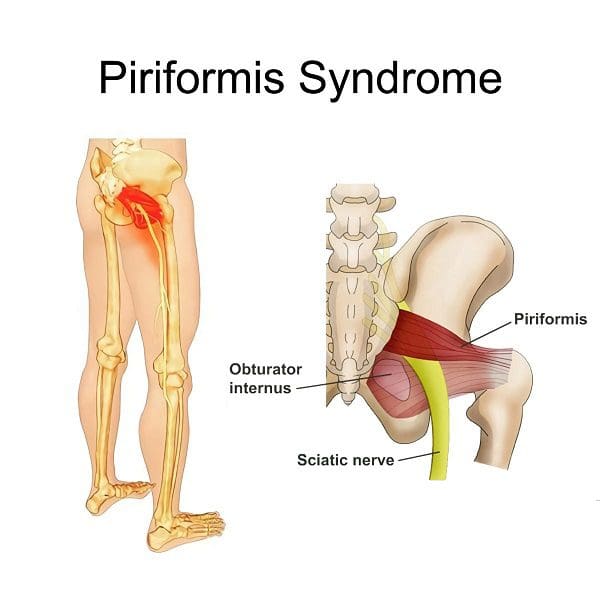
Overview
Piriformis Syndrome is a condition where the small Piriformis Muscle, located in the buttock region, can press on or irritate the Sciatic Nerve. Many Doctors and other professionals mistake this condition for “True Sciatica” which is where the Lumbar Spine degenerates and pinches the Sciatic Nerve. Usually Piriformis Syndrome will be incorrectly diagnosed as “Sciatica” just because it affects the Sciatic Nerve. The piriformis muscle, as it irritates the sciatic nerve, will cause pain, numbness and a tingling feeling along the leg and into the foot.
Anatomy
The piriformis muscle is one of 6 muscles known as the “Deep 6” and form the wider gluteal muscles or glutes in the buttock region. The Piriformis muscle alongside the other 5 muscles work together to bring the femur bone into external rotation in the hip socket. The other muscles that form the Deep 6 are the gemellus superior, gemellus inferior, obturator externus, obturator internus, and the quadratus femoris. The piriformis muscle sits over the Sciatic Canal where the sciatic nerve runs through and thus why Piriformis Syndrome gives you sciatic pain.

Symptoms
Piriformis syndrome is quite literally a pain in the ass! The symptoms will typically start with either pain in your bum, lower back, numbness or tingling down from the bglutes and down the leg. This usually only presents in one side but in extreme cases can be in both legs depending on various factors. If you do suffer with pain this can range from a minor irritant to extreme pain which can run down the length of the sciatic nerve which runs down into the toes. This pain is known as Sciatica because it affects the nerve but is not as serious as true sciatica which is to do with issues in the lumber vertebrae. The pain is caused from the piriformis muscle compressing or irritating the sciatic nerve.
Causes
The exact causes of piriformis syndrome are unknown, hence the “syndrome” terminology. However there are suggestions and suspected causes such as:
- Tightness in the Piriformis muscle or a spasm. This can be because of over training, incorrect footwear, sitting for long periods of time or even tightness in the quad muscles that can affect the tilt of your pelvic bone.
- Injury or Swelling of the piriformis muscle.
- Bleeding in the area of the piriformis muscle.
One or a multiple array of the above issues can cause Piriformis Syndrome of the above problems can affect the piriformis muscle.
Diagnosis
There is no definitive test for piriformis syndrome. In most cases just using questioning and getting a history of when the pain started, where the pain / tingling is etc the practitioner can usually have a good idea whether it is Piriformis Syndrome or Sciatica. In some cases, a contracted or tender piriformis muscle can be found on palpation / physical exam.
Treatment
There are a number of ways you can treat Piriformis Syndrome most will involve finding ways to strtetch or loosen off the muscle itself. Starting with the lease invasive and least painful:
- Take a hot bath and use hot water bottles on and around the glute / bum muscles as often as you can, at least twice a day. This will help relax the muscles if there has been a tightening or spasm.
- Trigger Pointing the piriformis muscle. If you have an good understanding of the glute anatomy, you can use a foam roller or trigger pointing ball (or a golf ball etc) to apply pressure to the piriformis in order to force it to relax and length.
- Stretching the Glute muscles, Hamstring Muscles, Lower Back (Quadratus Lumborum) and Quad (front muscles). Some may argue the anterior leg muscles however if they are tight they could be giving your pelvis an anterior tilt which by lengthening the Piriformis muscle too much can cause it to press against the sciatic nerve.
- Massage therapy. A good qualified sports therapist can provide a high level massage therapy / sports massage which can include things such as soft tissue release, neuromuscular therapy and general lengthening and loosing techniques to manipulate the muscle to relax.
Exercises
Glute Max Stretch
Piriformis Stretch
Hamstring Stretch
Quadricep Stretch
Trigger Point the Piriformis Muscle
Please see some exercises and stretch examples in our video.
Prevention
As this is a syndrome and the direct cause of this condition is unknown we would recommend if you are in a seated job to get up and stretch the hamstrings and glutes from time to time or adjust your sitting position so your legs do not continually get placed under the chair shortening the hamstrings for example.
Walking can also help as this will use antagonist muscles to help relax the posterior chain.
Reducing any sporting activity that you feel is increasing the symptoms.



